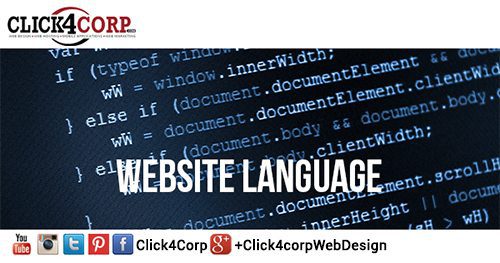
Two Basic Website Languages: A Guide To Choosing The Right Code
In the vast world of website development, the choice of programming language is a crucial decision. When selecting the code for your website, it’s essential to keep in mind that there is no official “best” language. This brief guide aims to assist you in deciding which language is likely to fit your project best, focusing in website languages.
Two Basic Website Languages
In the ever-evolving landscape of web development, the importance of selecting the appropriate programming language cannot be overstated. With no official “best” language, a brief overview can be your compass in navigating this decision.
II. HTML and CSS
A. Definition and purpose of HTML
HTML, or Hyper Text Markup Language, serves as the standard markup language. It constructs the fundamental structure of a webpage, facilitating the formatting of media and content.
B. Role of CSS in web development
Complementing HTML, Cascading Style Sheets (CSS) comes into play. CSS controls and designs how media and content in the HTML file appear on a webpage. Together, they create the foundation for a visually appealing static website with a focus on website languages.
III. Dynamic Websites
A. Introduction to dynamic websites
While HTML and CSS lay the groundwork, dynamic websites involve additional programming languages categorized into client-side and server-side scripting.
B. Distinction between client-side and server-side scripting
Client-side scripting operates within a user’s web browser, whereas server-side scripting runs on the web server hosting the site. This dichotomy sets the stage for a dynamic and interactive online experience.
IV. Server-Side Scripting Languages
A. JavaScript for dynamic effects and interactivity
JavaScript, a powerful server-side language, enables the creation of animations, games, applications, and interactive elements on a webpage. Its versatility enhances user engagement and experience in the realm of “Website Languages.”
B. ActionScript for Flash animation and media streaming
ActionScript finds its niche in websites utilizing Flash animation and media streaming. It’s the language behind Adobe Flash, adding a layer of creativity and multimedia richness.
V. Database Management
A. Overview of server-side languages for database management
Server-side scripting extends beyond visual elements to managing databases, a crucial aspect of “Website Languages.” This ensures efficient data handling, contributing to the overall functionality of a website.
B. Security advantages of server-side scripting
Server-side languages offer enhanced security, as critical scripts run on the server, preventing the exposure of source code on the client’s terminal.
VI. PHP
A. Common usage and prevalence on web servers
PHP, a widely adopted server-side language, is employed on approximately 75% of all web servers. Its popularity stems from its compatibility with smaller websites with lower traffic designs, making it a notable player in the landscape of “Website Languages.”
B. Suitability for smaller websites with lower traffic designs
PHP’s sweet spot lies in smaller projects where its efficiency and open-source nature shine. Its supportive community adds to its appeal, creating a robust ecosystem for developers interested in exploring “Website Languages.”
C. Community support for PHP
The expansive PHP community provides valuable resources and support, making it a reliable choice for developers seeking assistance and collaboration in the realm of “Website Languages.”
VII. Java
A. Preferred language for large websites with high traffic
For substantial websites with high traffic, Java emerges as a preferred choice. Major companies, such as the Apple app store and Amazon.com, leverage Java frameworks to manage their web presence.
B. Java frameworks and their usage by major companies
Java’s dominance in speed tests positions it as a top performer for large-scale applications, ensuring server-based web applications operate with optimal efficiency, emphasizing its role in shaping “Website Languages.”
VIII. Ruby
A. Productivity enhancement with short, simple code
Ruby stands out for its focus on productivity. Its short and simple code allows developers to achieve tasks with ease, boosting overall efficiency.
B. Syntax differences and multiple ways of achieving tasks
Ruby’s syntax differs, offering developers various ways to accomplish tasks. This flexibility, while unique, emphasizes efficiency and creativity. Noteworthy platforms like Hulu and Twitter utilize Ruby for its advantages.
C. Usage on high-traffic sites like Hulu and Twitter
High-traffic websites like Hulu and Twitter rely on Ruby, showcasing its scalability and effectiveness in managing extensive user interaction.
IX. Personal Preferences in Language Choice
A. Setting goals for the website
Before making a decision, it’s crucial to set clear goals for your website. Understanding the project’s objectives will guide you towards the most suitable language, aligning with the core concept of Website Languages.
B. Assessing project requirements
Evaluate the specific requirements of your project. Consider factors like scalability, interactivity, and multimedia needs to narrow down your options effectively,.
C. Choosing tools based on project needs
With goals and requirements in mind, you can make an informed choice. The array of languages provides diverse tools to match the unique demands of your project, ensuring a seamless integration of website Languages.
X. Conclusion
In the ever-evolving realm of website development, the choice of programming language is a personalized journey, intricately connected to the diverse world of “Website Languages.” Each language has its strengths, and aligning those strengths with your project’s goals is key. There’s no one-size-fits-all solution, but understanding your needs ensures a smoother development process.
Choose Click4Corp!

Two Basic Website Languages: A Guide To Choosing The Right Code
Click4Corp, a leading digital marketing agency, understands the pivotal role of website languages in crafting a compelling online presence. Specializing in SEO optimization, Click4Corp helps businesses navigate the dynamic world of web development by offering tailored solutions in HTML, CSS, and various server-side scripting languages. With a keen eye on creating dynamic and interactive websites, their team of experts excels in utilizing languages like JavaScript, PHP, Java, and Ruby to enhance user engagement and overall website functionality.
Whether you’re a small business seeking efficient PHP solutions or a large enterprise aiming for Java-driven excellence, Click4Corp is your strategic partner. Take the first step towards a powerful online presence by contacting us at (469) 441-4678. Let Click4Corp transform your website language choices into a competitive advantage, driving success in the digital landscape.
